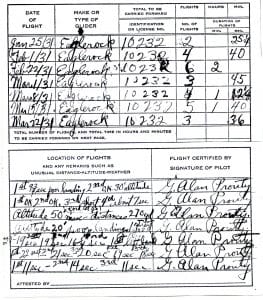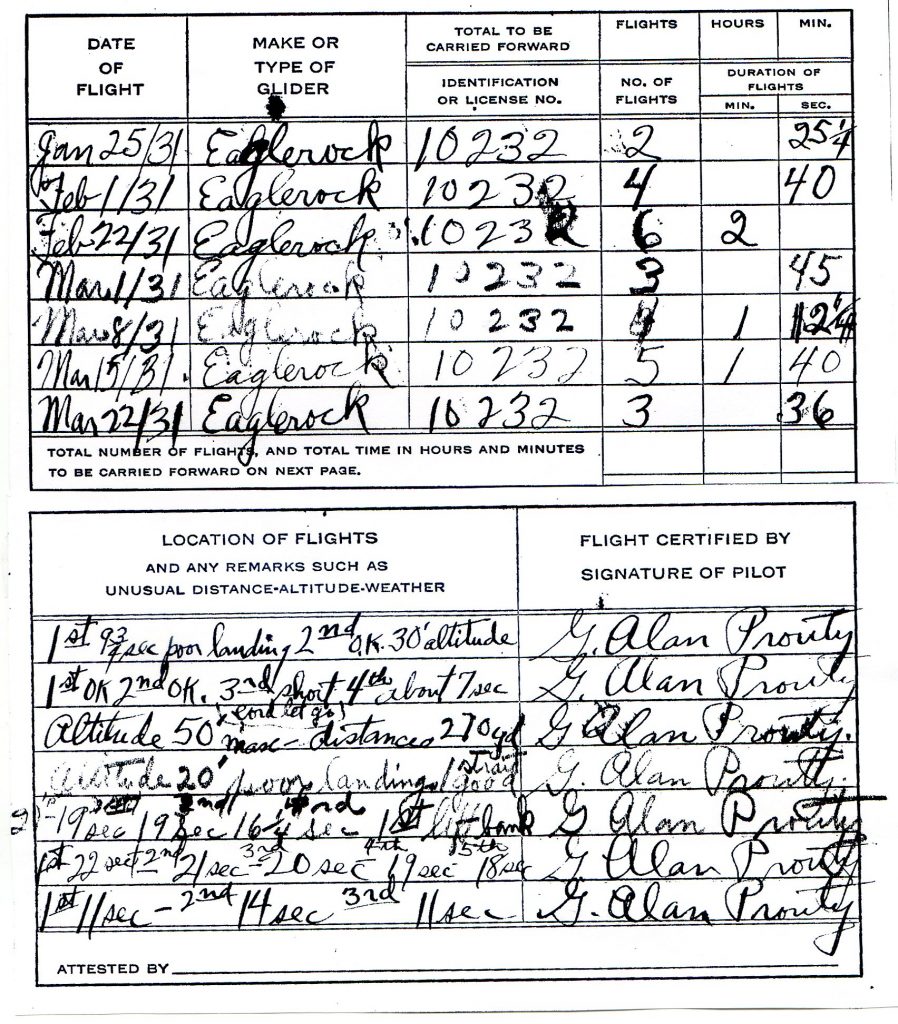Community Groups & Organizations, Napa, People
Napa’s First Glider Club
by Marie Bowen

In December 1930, 38 years before the Calistoga Soaring Center opened on the abandoned Calistoga Air Field, a group of Napans formed the Napa Glider Club. Organized by Guy Winfrey, an 1898 San Juan Hill veteran, the group included Ernie Mollo, H. Baker, Bob Shearer, Pete Peterson, Phil Dobie, Harry Burrows, Réne Leplat, Joe Elmore, Harold French, Pop Gardner, George York, John Black, E. Low (from Solano County), and George Alan Prouty, whose father, in 1898, had walked nearly 500 miles from Skagway to Dawson. Mr. Prouty’s letter to Jess Doud, dated July 31, 1981, and his subsequent 1982 and 1986 interviews provided the information for this story.
With little or no aviation experience but much enthusiasm, the men paid $425 for a new Eagle Rock glider, which arrived from Denver in three large cardboard boxes, 18 feet long. Auto mechanic Ernie Mollo put the glider together, and the group took it to the high school grounds for its maiden flight. It crashed. And the next week, lifting off from a different location, it crashed again. Welder Réne Leplat and mechanic Harold French kept the Eagle Rock functioning and, eventually, the group moved its headquarters to the Filippini Ranch near Stornetta’s Dairy. As Mr. Prouty explained, “This was a great place. There were no trees and you could glide right down to the Santa Rosa Railroad tracks. It was here that we built a pole hangar, made from old poles from PG&E. We built the hangar around the glider and were able to keep it out of sight.”
Once in the air, the Eagle Rock flew to a height of about 125-130 feet, with an average flight lasting about 30 seconds for about half a mile. It had a 36 foot span with 198 square feet of wing area. After the glider landed in a nearby field, it was dragged back up the hill by automobile. Then, as Mr. Prouty said, “We’d set it up and start all over again. It was a lot of fun.” The club’s secondary plane was part glider, part sail plane, with a 47 foot wing span. It allowed for a slight amount of soaring, unlike the glider which was, in his words, “simply a sled.”
The Napa Glider Club disbanded in November 1931 due to a growing lack of interest and a final wind storm that blew the Eagle Rock out of its hangar and into a field. Another reason for disbanding probably was the untimely death of Joe Elmore, “an excellent pilot,” when the plane he was flying stalled and crashed in mid-1931 in Utah.
Thirteen years later, gliders were at Omaha Beach. One of Mr. Prouty’s two interviews with Jess Doud provides some generally unknown facts about their use during WWII:
The German Army was not able or allowed, under the Treaty of Versailles, to train a certain number of pilots…what they did was train their pilots in gliders, and they trained the very best…in 1939, they were able to put 10,000 first-class pilots into the field. The U.S. army, in 1944 on D-Day, sent over 2,000 fully armed troops in gliders…sort of a kamikaze operation, because most of those fellows knew they weren’t coming back…three gliders (tied) behind each bomber and each glider had 75 fully armed troops in it.
They took them to France and released them at about 1300 feet…when you’re in a glider with no power, the only thing you can do is go down. Out of 2,000 men behind the German lines, there were about 50 percent casualties in deaths and injuries. But the idea was to disrupt the Germans and, at the same time, we had the paratroopers coming in at the top. The paratroopers had to risk their lives, too, because the Germans would snipe them…to a certain degree, the glider troops and the troops from the air made a big difference on D-Day, backing up the people at Omaha Beach. While they had tremendous casualties, they were people who volunteered for that job.
Reference List
Abandoned and Little-Known Airfields of California. Online at www.airfields-freeman.com/CA/Airfields
Oral History Tapes #37 and #89, NCHS Oral History Collection
Manuscript #79, NCHS Manuscripts Collection


